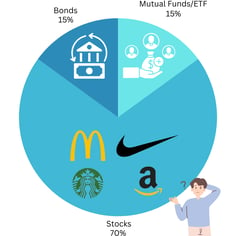Smart Investing for Teens: Building Wealth Early
You might think investing is only for those with full-time jobs and a large nests of savings, but the truth is, we have the advantage when it comes to investing due to the "8th wonder of the world"-- compound interest. Investing isn’t about becoming a millionaire overnight—it’s about building wealth slowly over time. By starting young, even with small amounts, we can take advantage of compound growth (aka. money making more money) and set ourselves up for a future of financial freedom.
10/28/20245 min read


What is Investing?
Investing is putting money into something with the expectation it will grow in value over time. There are many ways to invest, like:
Stocks: Owning a small piece of a company.
Bonds: Lending money to companies or governments in exchange for interest.
Mutual Funds & ETFs: Groups of investments pooled together, letting you buy into many stocks or bonds at once.
2. Youth Investment Accounts
What It Is: Some platforms have created accounts specifically designed for teens, making it easier to invest with guidance.
Popular Options:
Fidelity Youth Account: Available for teens 13-17, this account offers no commissions on trades and comes with parental supervision.
Stockpile: Allows teens to invest with a custodial account, with the added bonus of buying fractional shares (small parts of a stock).
How to Start: A parent or guardian can set up and supervise these accounts until you turn 18.
3. Investment Apps for Custodial Accounts
What It Is: Some investment apps are specifically designed for custodial accounts, making it easy to invest small amounts and learn how to invest.
Popular Options:
Acorns: Rounds up your everyday purchases and invests the spare change.
Greenlight: Offers a debit card and an investing platform for kids, letting you invest in stocks with parental approval.
How to Start: A parent can set up the account and help manage your investment goals.
4. 529 College Savings Plans
What It Is: 529 plans are investment accounts (that vary state to state) specifically for education expenses. While they’re not traditional brokerage accounts, they allow investments that grow tax-free if used for qualified education costs. Some state offer tax deductions for contributions as well.
Benefits: Great for long-term growth with the goal of covering college or other educational expenses.
How to Start: Parents can set up a 529 plan with your state’s program or a brokerage firm. You can search up "your state followed by 529" (Virginia 529) for more information about your particular state's terms.






How To Start Investing For Teens?
While it is true that you typically need to be 18 to open a traditional investment account, there are still ways to gain exposure into the habit investing.
*And keep in mind, investing is not about betting on risky stocks, it is about staying consistent investing in safe long-term equities(bonds, mutual funds, target-date, index funds
1. Custodial Accounts
What It Is: A custodial account is a brokerage account set up in your name but managed by a parent or guardian until you reach the age of majority (usually 18 or 21, depending on the state).
Types:
UGMA (Uniform Gifts to Minors Act): Allows investments in stocks, bonds, and mutual funds.
UTMA (Uniform Transfers to Minors Act): Similar to UGMA but with a wider range of assets like real estate.
How to Start: Ask a parent or guardian to open a custodial account with you. Popular brokerage platforms like Fidelity, Charles Schwab, and Vanguard offer these accounts.
5. Roth IRA for Teens
What It Is: A Roth IRA is a retirement account where you contribute post-tax money, letting it grow tax-free until retirement. As a teen, you’re eligible to open a custodial Roth IRA if you have earned income (like a part-time job).
Benefits: It’s one of the best long-term investment vehicles due to its tax advantages.
How to Start: A parent can help you open a custodial Roth IRA through brokerages like Fidelity or Schwab.


Tips for Teen Investors
Build a Base
Before you start investing in single stocks, be sure to build a base of safe investments. The most popular route is low-cost index funds such as S&P500 index funds (VOO) or the Fidelity 500 Index (FXAIX). You can also look to buying government bonds or CD's that offer predictable income, though they don't offer high returns.
While I don't recommend buying single stocks right off the back, if you love a brand or company, research it! Do they make profits? Are they popular among your friends? This can be a good starting point. Personally loved Cava, so I bought shares of it! Now I can say I own Cava while enjoying the stock appreciation, with my base built of course.
Don’t put all your money in one stock or type of investment. Spread it out to manage risk. You can put 70% of your money in the stock market, 20% in treasury bonds, and 10% in CDs. The combinations really just depend on what your goals are. If you want to be more risky for higher returns, you would allocate most of your money in the stock market. If you want slow and steady income, then you can allocate more into bonds and CDs.
Invest in what you know
Diversity
Dollar Cost Average
If you are overwhelmed by all this information and just want to put money somewhere and forget it while it grows, then you may want to consider dollar cost averaging. This is a popular strategy which involves setting aside a predetermined amount each month or year or week to invest in a predetermined group of investment products. So every month you may set aside $100 to invest in a index fund and never look at it again, though you want to make sure the product you are investing in is safe, especially if you'll forget about it.
Maybe you have a job or allowance and receive steady income. Then you may want to consider automatically transferring this income directly into your investment account. But always remember to set aside money for your savings first, then what ever is left over can be invested. For example you may create a budget that allocates 15% into savings, 15% into investments, 20% for fixed expenses, and 50% for discretionary expenses.
Think Long-Term:
Automate your investment
Avoid “get-rich-quick” schemes or stock tips that seem too good to be true. Real investing is about the long game. Remember we have the power on compound interest on our side, so our efforts will pay off big time in the long run.
Investing as a teen may seem like a small step, but it’s one of the smartest moves you can make for your future. Starting early gives you the unique advantage of time, allowing your money to grow and benefit from the power of compound interest. Learning how to invest now also helps you build healthy financial habits and knowledge that will guide you through major life milestones. Whether it’s through a custodial account, a Roth IRA, or a youth account, its never to early to start investing. Just remember the tips and to do your research before diving in.
Overall, if you do start to invest, it is a powerful tool to help you achieve all your short, mid, or long terms goals. Having that money ready and working for you enables you to make purchases ls. By starting now, you’re setting yourself up to afford the big purchases and experiences that matter to you, like buying a car, funding college, or even saving for a first home down the line. Even if they seem far away, this is a great way to gain a head start and your future self will thank you.
Next week we will talk about one of the biggest purchases you will definitely want to start investing for... COLLEGE!
We will explore ways to pay for college and talk about the FAFSA, see you guys next week!
Follow Us!
Join us to learn and grow financially together.
© 2024. All rights reserved.
